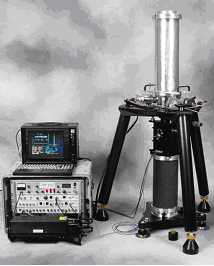For Volcanologists, they use many instruments to predict eruptions such as:
A seismometer / seismograph
A seismometer (or seismograph) is a sensor that detects the intensity of earthquakes caused by magma that is moving. It has been around for almost 2,000 years. The first seismograph was invented by a Chinese scientist. It looked like a large jar with dragon heads on every side. Each dragon had a metal ball in its mouth, and when an earthquake struck, one of the balls would drop into the open mouth of a toad sculpture below. By looking at which ball dropped, Heng (the inventor) said he could tell from which direction the earthquake came.
Luigi Palmieri invented a seismograph in 1856 while working near Italy's Mt. Vesuvias. He wanted a way to predict eruptions, and knew that tremors were usually felt before an eruption. The seismograph uses a pendulum to record movement of the ground below it. The squiggly lines recorded on paper by a seismograph are called a seismogram.
A Gravimeter
Since magma gives off electric currents, electric meters are used tospot rising magma levels by measuring its electric current. Gravimeters can also detect flowing magma.
A Landsat Satellite
Scientists also take temperatures and gauge gas by using a Landsat satellite. The satellite uses infared sensors to detect temperatures and changes in volcanoes. Aircraft monitors the amount of gas released from the ground. An increase in sulfur dioxide and other gases usually means that there could be volcanic eruptions.
 |
| A Tiltmeter |
The tiltmeter is a sensor that uses a laser beam to find the rising or lowering of magma levels by measuring changes in ground elevation.
 |
| GPS |
GPS (Global Positioning System) is a method to determine position of locations on Earth. It uses satellites that broadcast a signal and receivers that pick up and record the signal. GPS uses the relationship between velocity, distance, and time (velocity equals distance divided by time). With GPS, the velocity is the speed of light. Knowing the velocity and time (and the position of the satellite) allows the distance to be calculated. As magma moves up into a volcano the volcano swells and distances between points on the volcano increases (think of dots on a balloon) and the elevation at specific points increases. Such a change is a common occurrence prior to an eruption.
(Source: http://library.thinkquest.org/
Volcanologists use these instruments to successfully predict eruptions which saves many lives. Scientists are trying to develop new ways to predict future eruptions.
For the ordinary people, they can predict a volcano by:
1. Looking for plumes of smoke or clouds of gas on or around the volcano that aren't typically there. As magma flows into the chambers beneath a volcano and rises to the surface, it can cause different gases to be released, which geologists keep a close eye on for changes in quantity or composition.
2. Looking out for any changes in seismic activity near the volcano. Many volcanoes continuously give off rumbles or tremors, but a sudden increase in the number or strength of these quakes can indicate impending eruption.
3. Taking note of strange activity that you may not immediately recognize as a tremor. While tremors may be obvious, rumbling and causing objects to rattle, they may also have seemingly no effect on a sturdy building and may just sound like a passing airplane or truck.
4. Observe any alterations in the shape or elevation of the ground in the surrounding area. Bulges, cracks or increased slope in the ground are all indicators of activity beneath.
5. Check with local rangers or members of the U.S. Geological Survey to see if the volcano has erupted in recent history. If it has, then geologists will have labeled it as an "active" volcano, which increase the likelihood of an eruption in the future.
- Points obtained by Charmaine Tan Wen Qian
- Vetted And Edited by Yap Way Shen Russell



No comments:
Post a Comment